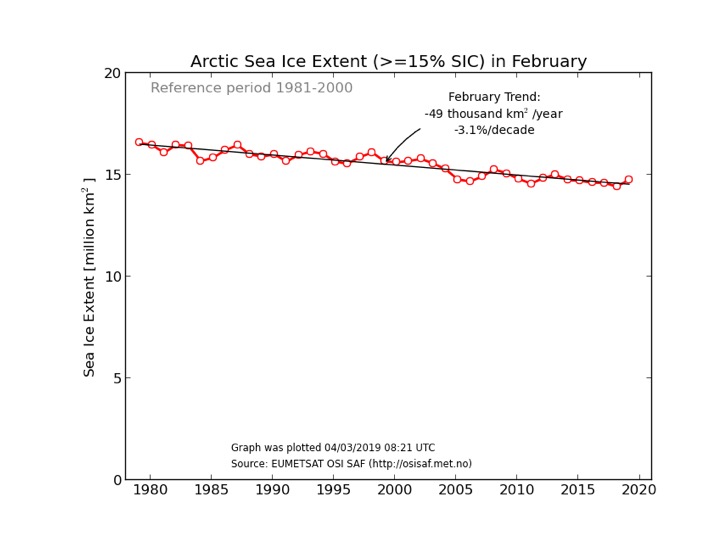Le DMI (Danish Meteorological Institute) publie régulièrement l’évolution temporelle, mois par mois, de l’étendue de la glace de l’Arctique. Le site SCE met en ligne les ‘updates’ concernant cette évolution depuis l’update d’octobre 2018 .
L’étendue de la glace arctique de février 2019 est plus grande que celles des mois 2005-2006-2007 et la plus étendue depuis 2013.

Egalement se reporter à Connolly et al. 2017 pour l’évolution à plus long terme (depuis 1900).
La lecture de l’étude Connolly et al. 2017 mentionnée ci-avant est révélatrice de « longs phénomènes CYCLIQUES relatifs à l’étendue de cette glace Arctique » sur un horizon plus intéressant que celui 1981-2019 figuré sur le graphique mensuel du DMI …
Jugeons-en par leur ABSTRACT et chapitre 6. CONCLUSIONS reproduits ci-dessous ?
Les gazettes promptes à rapporter sans nuances les seules observations récentes feraient preuve d’honnêteté intellectuelle à rapporter les constats vers leurs lecteurs!
…………………………………………………………………………………………………………………
Re-calibration of Arctic sea ice extent datasets using Arctic surface air temperature records
Ronan Connolly a, Michael Connolly a and Willie Soon b
a Independent scientists, Dublin, Ireland;
b Harvard-Smithsonian Center for Astrophysic Center for Astrophysics Solar, Stellar and Planetary Sciences Division, Cambridge, MA, USA (2016 , 25p.)
ABSTRACT
A new seasonal and annual dataset describing Arctic sea ice extents for 1901–2015 was constructed by individually re-calibrating sea ice data sources from the three Arctic regions (North American, Nordic and Siberian) using the corresponding surface air temperature trends for the pre-satellite era (1901–1978), so that the strong relationship between seasonal sea ice extent and surface air temperature observed for the satellite era (1979-present) also applies to the presatellite era.
According to this new dataset, the recent period of Arctic sea ice retreat since the 1970s followed a period of sea ice growth after the mid-1940s, which in turn followed a period of sea ice retreat after the 1910s. Arctic sea ice is a key component of the Arctic hydrological cycle, through both its freshwater storage role and its influence on oceanic and atmospheric circulation. Therefore, these new insights have significance for our understanding of Arctic hydrology.
https://www.tandfonline.com/doi/pdf/10.1080/02626667.2017.1324974
(…)
6 CONCLUSIONS
In this article, we developed and presented a new dataset describing seasonal and annual Arctic sea ice extents for the period 1901–2015. Our dataset consists of separate seasonal indices for three Arctic regions (North American, Nordic and Siberian) as well as composite indices for the entire Arctic Ocean and seas, although excluding those non-Arctic Northern Hemisphere seas with seasonal sea ice (e.g. Sea of Okhotsk, Bering Sea, Gulf of St Lawrence).
According to this new dataset, the recent period of Arctic sea ice retreat since the 1970s followed a period of sea ice growth after the mid 1940s, which in turn followed a period of sea ice retreat after the 1910s. Our reconstructions agree with previous studies that have noted a general decrease in Arctic sea ice extent (for all four seasons) since the start of the satellite era (1979). However, the timing of the start of the satellite era is unfortunate in that it coincided with the end of several decades during which Arctic sea ice extent was generally increasing.
This late-1970s reversal in sea ice trends was not captured by the hindcasts of the recent CMIP5 climate models used for the latest IPCC reports, which suggests that current climate models are still quite poor at modelling past sea ice trends. Nor is it described in previous Arctic sea ice reconstructions such as the Walsh dataset or the widely used HadISST sea ice dataset, although some recent studies have noted similar reversals, e.g. Pirón and Pasalodos (2016) and Alekseev et al. (2016).
As we saw from Figure 1, and Tables 1 and 2, Arctic sea ice is a key component of the Arctic hydrological cycle. So, this new dataset should be of use for improving our understanding of Arctic hydrology.
………………………………………………………………………………………………………………………